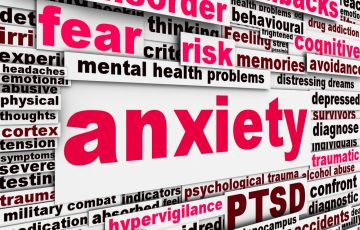Most people only really know about a couple of Anxiety Disorders, so I thought I’ll share some (very brief) information about them including types that you might be less aware of.
Specific Phobias: This is where someone has an extreme and irrational fear of a specific stimulus, to the point where people will avoid it or endure it with dread. There are common ones like fear of spiders and then rare ones like ‘Anatidaephobia’ (the fear that you are being watched by a duck).
Agoraphobia: This is when someone has an extreme and irrational fear of leaving their house or being in public situations. They generally cope by avoiding the situations altogether.
Social Phobias: This is when someone has an extreme and irrational fear of social situations to the point of avoiding them. This is often associated with low self esteem and assumptions that others are judging them.
Panic Disorder: This is when someone has recurrent and unpredictable panic attacks, which are not restricted to specific situations.
Obsessive Compulsive Disorder: This is when someone has a obsessive intrusive thoughts about something bad happening to them or their family and feels that they have to engage in compulsive behaviours to avoid these things happening. There is a wide range of behaviours they can engage in including cleaning excessively till their hands bleed, check the locks on their doors repeatedly to the point where they go to bed at midnight or saying phrases repeatedly in their head to the point where they can’t concentrate. They generally hate engaging in these behaviours but feel that they have to otherwise something terrible with happen.
Acute Stress Reaction: This is when someone has an immediate response to acute stress. They will seem like they are in a daze. It’s likely to last a few hours if they are able to get away from the situation or 1-2 days if not.
Post Traumatic Stress DIsorder: This is usually when someone has been though a traumatic experience and is now struggling with symptoms like flashbacks, dissociation, hypervigilance and nightmares.
Adjustment Disorder: This is usually when someone is unable to cope with a change in their life. They may feel depressed and anxious or show reckless behaviours like fighting, driving carelessly, not caring about their responsibilites, skipping school, etc.
Dissociative Conversion Disorder: This is where someone has a lack of integration between their memories, identity, movement and sensations. It often occurs suddently within a few weeks of a stressful situation. The presentation can vary from hour to hour.
Dissociative Amnesia: This is where somsone is experiencing amnesia as a result of a trauma. It’s necessary to rule out intoxication, head trauma, etc before diagnosing.
Dissociative Fugue: This is where someone experiences Dissociative Amnesia accompanied by suddenly travelling away from home or work. They sometimes establish new identities in new places with little memory of how things were before. They are usually able to maintain their self care and interact with others.
Dissociative Stupor: This is where they have a lack of voluntary movement, speech or normal responses to external stimuli. This is generally associated with trauma.
Dissociative Identity Disorder: We all have lots of different identities when we are young and around 8 years old these identities tend to integrate into one cohesive identity. However, if someone has experienced significant trauma during their early years then they can end up developing amnesic walls between the different identities as a way of containing the traumatic memories. One identity will know about the trauma and another identity won’t be as aware of what has happened, allowing them to then continue to function in day-to-day situations. These amnesic walls mean that the person ends up with multiple personalities, who each develop their own ages, genders, mannerisms, preferences, and opinions. They can switch between these personalities, eg being a 5 year old girl in one moment and then a 25 year old male in the next moment. It’s a very complex condition and often misunderstood by the public. These people are just trying to survive and generally aren’t dangerous to anyone else.
Somatoform Disorders: This is where the person has recurrent presentations of symptoms and requests for examination despite negative tests and reassurance from others. Hypochondriacal delusions would need to be ruled out before diagnosis.
Somatitisation Disorder: This is where the person has more than 2 years of multiple, recurrent, frequently-changing presentations of symptoms despite negative tests. They generally want treatment whereas someone with hypochondriacal disorder often just wants confirmation that they are ill.
Generalised Anxiety Disorder: This is where the person has persistent free-floating worry and fear of the future to the point where it affects their functioning or causes distress.
You can look at the ICD 10 (classification guide) for the actual diagnostic criteria. Please speak to a doctor, psychiatrist or psychologist if you feel you are experiencing any of these symptoms rather than self-diagnosing.
